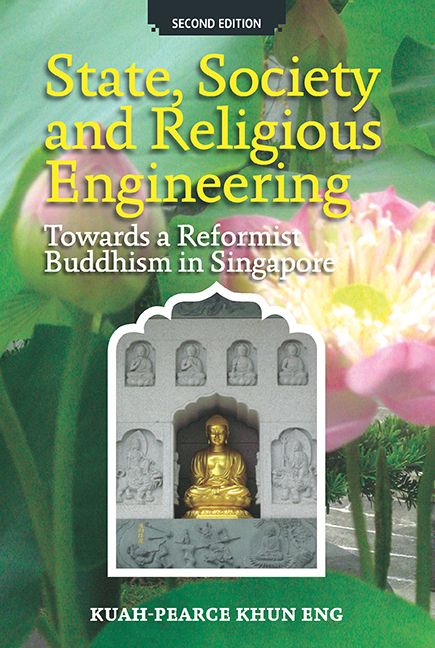Book contents
- Frontmatter
- Contents
- List of Diagrams
- Note on Romanisation
- Preface to the Second Edition
- Acknowledgements to the Second Edition
- Introduction
- PART 1 INVENTING A RELIGIOUS TRADITION
- PART 2 STATE, SOCIETY AND RELIGIOUS ENGINEERING
- 3 Bureaucratising the Temple and the Sangha
- 4 Establishing an Ethno-Religious Framework and the Religious Law
- 5 Buddhist Welfare and Charity
- 6 Experimenting with Religious Values as Asian Values
- PART 3 TOWARDS A REFORMIST BUDDHISM
- Conclusion
- Postscript to the Second Edition: Towards a Humanist and Socially-engaged Buddhism
- Glossary
- Bibliography
- Index
3 - Bureaucratising the Temple and the Sangha
from PART 2 - STATE, SOCIETY AND RELIGIOUS ENGINEERING
Published online by Cambridge University Press: 21 October 2015
- Frontmatter
- Contents
- List of Diagrams
- Note on Romanisation
- Preface to the Second Edition
- Acknowledgements to the Second Edition
- Introduction
- PART 1 INVENTING A RELIGIOUS TRADITION
- PART 2 STATE, SOCIETY AND RELIGIOUS ENGINEERING
- 3 Bureaucratising the Temple and the Sangha
- 4 Establishing an Ethno-Religious Framework and the Religious Law
- 5 Buddhist Welfare and Charity
- 6 Experimenting with Religious Values as Asian Values
- PART 3 TOWARDS A REFORMIST BUDDHISM
- Conclusion
- Postscript to the Second Edition: Towards a Humanist and Socially-engaged Buddhism
- Glossary
- Bibliography
- Index
Summary
INTRODUCTION
Apart from reproducing the religious ideologies and ritual practices, the Chinese during the early years also reproduced the familiar institution of the village temple in colonial Singapore. Among the common terms for a temple are miao, gong, she and tang. These various terms are used interchangeably to denote Buddhist, Daoist and Shenist temples. The village temple emerged to cater to the functional needs of the peasants and later, in Singapore, of the migrants. Most Chinese were intimately involved in the religious life of the temple, for it fulfilled their individual religious needs. It was important for the Chinese, especially the women, to visit the temple and pray to their gods and deities for help and favour. Members of the Sangha, i.e., monks and nuns, lived in the temples. They were often seen as the embodiment of the institution of the temple because of their status and the roles they played within it. Traditionally, the temple and the Sangha functioned as a single entity.
However, in present-day Singapore, the temple and the Sangha are subjected to the process of bureaucratisation to make them “modern”, “rational” and accountable to the general public. As a result of this process of bureaucratisation, both the temple and the Sangha have different roles. The temple as a religious institution is engaged in both religious and secular activities while the Sangha as a monastic institution is engaged in the pursuit of religious activities. Only certain types of secular activities that are closely linked to religion such as those related to welfare and education can be pursued by individual Sangha members.
This chapter discusses how the process of bureaucratisation results in the separation of the Sangha and the temple. It also discusses the modernising roles played by the monks and nuns, the lay community and the Singapore State in restructuring Chinese religion and Buddhism to suit the modern needs.
EARLY TEMPLE STRUCTURE
In traditional China, there were two main types of temples, the large monasteries and the village temples. They emerged to cater to two separate groups of people. The monasteries were built for those who had chosen a monastic way of life, whose primary preoccupation was the pursuit of enlightenment. They were also seats of power, learning and much scholarship as well as significant economic institutions that controlled large stretches of rural land (Welch, 1967; Chen, 1973).
- Type
- Chapter
- Information
- State, Society and Religious EngineeringTowards a Reformist Buddhism in Singapore (Second Edition), pp. 91 - 131Publisher: ISEAS–Yusof Ishak InstitutePrint publication year: 2009

